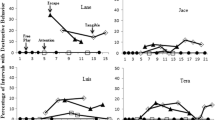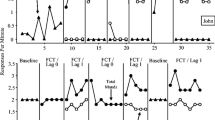Abstract
The purpose of this study was to evaluate whether destructive behavior and manding were maintained by the same social reinforcers. A summary of 10 participants that met criteria for differentiated functional analysis and mand analysis results were included in this study. All participants were preschool-aged children with developmental disabilities who engaged in destructive behavior. All procedures were conducted in the participants’ homes by their parent with investigator coaching. Functional analyses (attention, escape, and tangible test conditions) of destructive behavior and manding were conducted within multielement designs and showed social functions. The functional analysis of destructive behavior and functional analysis of mands identified the same reinforcers for only 2 of the 10 participants. The analysis of mands identified a reinforcer that was not identified by the analysis of destructive behavior for 5 participants (over-identification), did not identify a reinforcer that was identified by the analysis of destructive behavior for 2 participants (under-identification), and identified mixed reinforcers (combination of over-identification and under-identification) for 1 participant. Results suggest that the analysis of destructive behavior and the analysis of mands identified different reinforcers and are not interchangeable.



Similar content being viewed by others
References
Bowman, L. G., Fisher, W. W., Thompson, R. H., & Piazza, C. C. (1997). On the relation of mands and the function of destructive behavior. Journal of Applied Behavior Analysis, 30, 251–265.
Brown, K. A., Wacker, D. P., Derby, K. M., Peck, S. M., Richman, D. M., Sasso, G. M., et al. (2000). Evaluating the effects of functional communication training in the presence and absence of establishing operations. Journal of Applied Behavior Analysis, 33, 53–71.
Carr, E. G. & Durand, V. M. (1985). Reducing behavior problems through functional communication training. Journal of Applied Behavior Analysis, 18, 111–126.
Durand, V. M. (1999). Functional communication training using assistive devices: Recruiting natural communities of reinforcement. Journal of Applied Behavior Analysis, 32, 247–267.
Durand, V. M. & Carr, E. G. (1991). Functional communication training to reduce challenging behavior: maintenance and application in new settings. Journal of Applied Behavior Analysis, 24, 251–264.
Durand, V. M. & Carr, E. G. (1992). An analysis of maintenance following functional communication training. Journal of Applied Behavior Analysis, 25, 777–794.
Durand, V. M. & Merges, E. (2009). Functional communication training to treat challenging behavior. In W. O'Donohue & J. E. Fisher (Eds.), General principles and empirically supported techniques of cognitive behavior therapy (pp. 320–327). Hoboken: Wiley.
Grow, L. L., Kelley, M. E., Roane, H. S., & Shillingsburg, M. A. (2008). Utility of extinction induced response variability for the selection of mands. Journal of Applied Behavior Analysis, 41, 15–24.
Hagopian, L. P., Fisher, W. W., Thompson, R. H., Owen-DeSchryver, J., Iwata, B. A., & Wacker, D. P. (1997). Toward the development of structured criteria for interpretation of functional analysis data. Journal of Applied Behavior Analysis, 30, 313–326.
Harding, J. W., Wacker, D. P., Berg, W. K., Lee, J. F., & Dolezal, D. (2009). Conducting functional communication training in home settings: a case study and recommendations for practitioners. Behavior Analysis in Practice, 2, 21–33.
Lerman, D. C., Parten, M., Addison, L. R., Vorndran, C. M., Volkert, V. M., & Kodak, T. (2005). A methodology for assessing the functions of emerging speech in children with developmental disabilities. Journal of Applied Behavior Analysis, 38, 303–316.
Northup, J., Wacker, D., Sasso, G., Steege, M., Cigrand, K., Cook, J., et al. (1991). A brief functional analysis of aggressive and alternative behavior in an outclinic setting. Journal of Applied Behavior Analysis, 24, 509–522.
Peterson, S. M. P., Caniglia, C., Royster, A. J., Macfarlane, E., Plowman, K., Baird, S. J., et al. (2005). Blending functional communication training and choice making to improve task engagement and decrease problem behaviour. Educational Psychology, 25, 257–274.
Richman, D. M., Wacker, D. P., & Winborn, L. (2001). Response efficiency during functional communication training: effects of effort on response allocation. Journal of Applied Behavior Analysis, 34, 73–76.
Ringdahl, J. E., Falcomata, T. S., Christensen, T. J., Bass-Ringdahl, S. M., Lentz, A., Dutt, A., et al. (2009). Evaluation of a pre-treatment assessment to select mand topographies for functional communication training. Research in Developmental Disabilities, 30, 330–341.
Roane, H. S., Vollmer, T. R., Ringdahl, J. E., & Marcus, B. A. (1998). Evaluation of a brief stimulus preference assessment. Journal of Applied Behavior Analysis, 31, 605–620.
Shirley, M. J., Iwata, B. A., Kahng, S. W., Mazaleski, J. L., & Lerman, D. C. (1997). Does functional communication training compete with ongoing contingencies of reinforcement? An analysis during response acquisition and maintenance. Journal of Applied Behavior Analysis, 30, 93–104.
Tiger, J. H., Hanley, G. P., & Bruzek, J. (2008). Functional communication training: a review and practical guide. Behavior Analysis in Practice, 1, 16–23.
Volkert, V. M., Lerman, D. C., Call, N. A., & Trosclair-Lasserre, N. (2009). An evaluation of resurgence during treatment with functional communication training. Journal of Applied Behavior Analysis, 42, 145–160.
Wacker, D. P., Steege, M. W., Northup, J., Sasso, G., Berg, W., Reimers, T., et al. (1990). A component analysis of functional communication training across three topographies of severe behavior problems. Journal of Applied Behavior Analysis, 23, 417–429.
Wacker, D. P., Berg, W. K., & Harding, J. W. (2004). Maintenance effects of functional communication training. Rockville: Department of Health and Human Services, National Institute of Child Health and Human Development.
Wacker, D. P., Berg, W. K., Harding, J. W., Barretto, A., Rankin, B., & Ganzer, J. (2005). Treatment effectiveness, stimulus generalization, and acceptability to parents of functional communication training. Educational Psychology, 25, 233–256.
Wacker, D. P., Berg, W. K., Harding, J. W., & Cooper-Brown, L. J. (2009). Matching treatment to the function of destructive behavior. In P. Reed (Ed.), Behavioral theories and interventions for autism (pp. 3–21). New York: Nova Science.
Wacker, D. P., Berg, W. K., Harding, J. W., & Cooper-Brown, L. J. (in press). Functional and structural approaches to behavioral assessment of problem behavior. In W. Fisher, C. Piazza & H. Roane (Eds.), Handbook of applied behavior analysis. New York: Guildford.
Winborn, L., Wacker, D. P., Richman, D. M., Asmus, J., & Geier, D. (2002). Assessment of mand selection for functional communication training packages. Journal of Applied Behavior Analysis, 35, 295–298.
Winborn-Kemmerer, L., Ringdahl, J. E., Wacker, D. P., & Kitsukawa, K. (2009). A demonstration of individual preference for novel mands during functional communication training. Journal of Applied Behavior Analysis, 42, 185–189.
Author information
Authors and Affiliations
Corresponding author
Additional information
This research was supported by Grant RO1- HD029402 from the National Institute of Child Health and Human Development of the National Institutes of Health. The opinions expressed herein do not necessarily reflect the position of policy of that agency. The authors express our appreciation to Agnes DeRaad for assistance with manuscript preparation.
The first author completed an earlier version of this manuscript to fulfill University of Iowa Ed.S. requirements for a Ph.D. degree in School Psychology.
Rights and permissions
About this article
Cite this article
Schieltz, K.M., Wacker, D.P., Harding, J.W. et al. An Evaluation of Manding Across Functions Prior to Functional Communication Training. J Dev Phys Disabil 22, 131–147 (2010). https://doi.org/10.1007/s10882-009-9181-5
Published:
Issue Date:
DOI: https://doi.org/10.1007/s10882-009-9181-5




